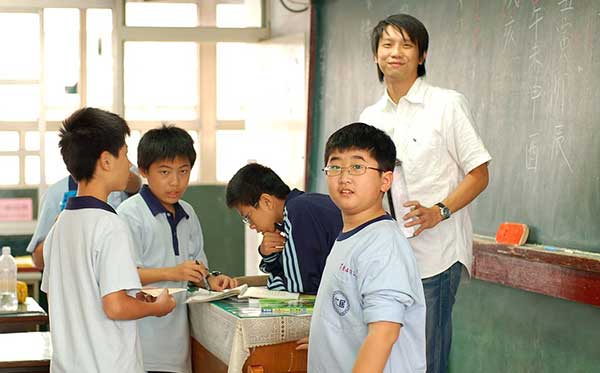
 This week an international league table suggested British pupils were lagging behind their Chinese counterparts. But is that fair, asks York head teacher John Tomsett?
This week an international league table suggested British pupils were lagging behind their Chinese counterparts. But is that fair, asks York head teacher John Tomsett?
If you differentiate [latex]12x^{2}[/latex] you get [latex]24x[/latex]. I can do more tricks like that! If you differentiate [latex]36x^{3} + 13x^{2} + 12x + 6[/latex] you get [latex]108x^{2} + 26x + 12[/latex].
I learnt those tricks when I was taught A level mathematics 30 years ago. I got a grade A in my A level mathematics. I have no idea what those tricks mean, but that didn’t seem to matter.
Like a performing monkey, in the exam room I could perform my tricks without understanding much at all about them.
What I wasn’t able to do, despite attaining my grade A, was apply my mathematics to the real world. I couldn’t problem solve using my mathematical knowledge.
Why should I be able to? The examination didn’t require me to use mathematics to problem solve, so my teachers never taught me how.
And that conundrum is at the basis of our relatively poor performance in the recently published PISA international league tables. Here’s an example of a PISA mathematics question:
A result of global warming is that the ice of some glaciers is melting. Twelve years after the ice disappears, tiny plants, called lichen, start to grow on the rocks.
Each lichen grows approximately in the shape of a circle.
The relationship between the diameter of this circle and the age of the lichen can be approximated with the formula:
[latex]d = 7.0 \times \sqrt{(t-12)} \: for \: t \geq 12[/latex]
where [latex]d[/latex] represents the diameter of the lichen in millimetres, and t represents the number of years after the ice has disappeared.
Using the formula, calculate the diameter of the lichen, 16 years after the ice disappeared. Show your calculation.
Now, that’s tricky, for sure. It’s testing how well you can apply your mathematic knowledge and understanding, but it’s not the approach to mathematics we’re taught consistently across our schools.
It’s important to note that there are other internationally recognised tests: TIMSS tests whether students have mastered specific knowledge and skills which, again, some countries focus on more than others. The UK does much better in TIMSS than PISA – and always has.
TIMMS questions are typically like the questions I used to master 30 years ago, and which our students face in their examinations today:
[latex]2a^{2} x 3a =[/latex]
A) [latex]5a^{2}[/latex]
B) [latex]5a^{3}[/latex]
C) [latex]6a^{2}[/latex]
D) [latex]6a^{3}[/latex]
Now you can see why we are better at TIMMS (Trends in International Mathematics and Science Study) test than PISA tests…
That’s not to say that the PISA tests can be ignored. They reveal how average we are internationally. They also show how Asia is outperforming us all.
The report is clear about the importance of high expectations and how the intense rigour of the schooling in Shanghai, for instance, results in the best academic performance of 15 year olds in the world.
Cultural differences

But education is a cultural product. Andreas Schleicher of the OECD – the producer of PISA tests – wrote in the Times Educational Supplement on 16 November 2012: “Today schooling needs to be much more about ways of thinking, involving creativity, critical thinking, problem-solving and decision-making.” And these are the aptitudes which have kept us in the top ten economies in the world for centuries.
The irony of ironies is that the Chinese want what we have. Zhejiang is a wealthy Chinese province south of Shanghai with a problem: its rote-learning centred education system does not cultivate students who can think creatively.
It means that the boardrooms of the rich Western companies based in Zhejiang are devoid of Chinese nationals.
After extensive R&D across Europe the Zhejiang Provincial government chose to forge links with secondary schools in a district of Denmark and our very own York.
Less than a year ago I signed a five year memorandum of cooperation with Mr Jin Yurong, the Principal of Jiaxing No 4 Middle School to develop a range of links which goes beyond student exchanges to pedagogic professional development.
Their web-site proudly proclaims that they pay special attention to research related to educational policy-making, reform, and innovation. In 2005, our school’s teachers published more than 80 papers, including three provincial level topics and two city level topics.
And they have chosen UK schools as a source of inspiration for their future developments.
British creativity
Our Chinese visitors found two features of our schools in York especially striking: firstly, that our children were evidently very happy – understandable that they should note that, considering the high levels of teenage suicide in China.
Secondly, that our children asked questions – to ask questions of teachers in a Chinese school would be to undermine the authority of the teacher.
Our creative instincts are what have kept us at the forefront of innovation as a nation for many centuries – we would be utterly foolish to dispose of them. What we have to do is raise our expectations of our children to Asian-like levels whilst retaining our ingenuity.
And when it comes to mathematics, we have to ban parents from saying, “Oh, it’s no surprise s/he can’t do maths, I never could when I was at school”, a comment that does no-one any good; it gives their child a green light to give up on mathematics. Parents would never say that they weren’t able to read and write.
When you hear someone say, I can’t do maths, just add the word… yet! It can be transformative – just ask a certain Carol Dweck, one of my educational mentors. If we all do that, we might just begin to challenge our Asian competitors!
- John Tomsett is head teacher of Huntington School in York
- Read all John’s YorkMix articles here
